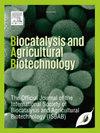Green synthesis of silver nanoparticles for antifungal activity against tomato fusarium wilt caused by Fusarium oxysporum
IF 3.4
Q2 BIOTECHNOLOGY & APPLIED MICROBIOLOGY
引用次数: 0
Abstract
Fusarium wilt caused by Fusarium oxysporum f. sp. radicis-lycopersici is one of the most important diseases in tomatoes, resulting in severe yield loss and mycotoxin infection in food and feed. The management of Fusarium wilt is based heavily on chemical fungicides, but these chemicals have many environmental concerns. Silver nanoparticles (AgNPs) are gaining importance as emerging resistance-free alternatives of chemical fungicides. In this study, AgNPs were synthesized using the aqueous leaf extract of Viola odorata as a green approach. The antifungal activity of these biosynthesised AgNPs was evaluated in vitro against F. oxysporum using the agar well diffusion method. AgNPs were also evaluated against tomato Fusarium wilt diseases using the foliar spray method in the greenhouse. The characterization of AgNPs revealed that AgNPs were of spherical shape, crystalline in nature, and had an average size of 18 nm. In the antifungal assay, 60 mg/l AgNPs strongly inhibited the growth of F. oxysporum with a growth zone of 18 ± 0.89 mm compared to fungicide (23 ± 1.20 mm) and AgNO3 (52 ± 2.33 mm). Similarly, 60 mg/l of AgNPs when sprayed on tomato plants in the greenhouse showed a survival rate of about 80% with no observable phytotoxic effect. This study provides a first baseline to control Fusarium wilt in tomato using biosynthesised AgNPs without affecting the health of crops.
银纳米粒子的绿色合成,用于对抗由镰孢菌引起的番茄枯萎病的抗真菌活性
由 Fusarium oxysporum f. sp. radicis-lycopersici 引起的镰刀菌枯萎病是番茄最重要的病害之一,会造成严重的产量损失,并在食品和饲料中产生霉菌毒素。镰刀菌枯萎病的防治主要依靠化学杀菌剂,但这些化学物质存在许多环境问题。银纳米粒子(AgNPs)作为新兴的无抗药性化学杀菌剂替代品,其重要性日益凸显。在这项研究中,我们采用一种绿色方法,利用 Viola odorata 的水性叶提取物合成了 AgNPs。采用琼脂井扩散法对这些生物合成 AgNPs 的抗真菌活性进行了体外评估。此外,还在温室中采用叶面喷洒法评估了 AgNPs 对番茄镰刀菌枯萎病的抗病性。AgNPs 的表征显示,AgNPs 呈球形,为晶体状,平均尺寸为 18 纳米。在抗真菌试验中,与杀真菌剂(23 ± 1.20 mm)和 AgNO3(52 ± 2.33 mm)相比,60 mg/l AgNPs 能强烈抑制 F. oxysporum 的生长,其生长区为 18 ± 0.89 mm。同样,在温室中对番茄植株喷洒 60 毫克/升的 AgNPs,其存活率约为 80%,且未观察到植物毒性效应。这项研究为利用生物合成的 AgNPs 控制番茄镰刀菌枯萎病提供了第一条基准线,而且不会影响作物的健康。
本文章由计算机程序翻译,如有差异,请以英文原文为准。
求助全文
约1分钟内获得全文
求助全文
来源期刊

Biocatalysis and agricultural biotechnology
Agricultural and Biological Sciences-Agronomy and Crop Science
CiteScore
7.70
自引率
2.50%
发文量
308
审稿时长
48 days
期刊介绍:
Biocatalysis and Agricultural Biotechnology is the official journal of the International Society of Biocatalysis and Agricultural Biotechnology (ISBAB). The journal publishes high quality articles especially in the science and technology of biocatalysis, bioprocesses, agricultural biotechnology, biomedical biotechnology, and, if appropriate, from other related areas of biotechnology. The journal will publish peer-reviewed basic and applied research papers, authoritative reviews, and feature articles. The scope of the journal encompasses the research, industrial, and commercial aspects of biotechnology, including the areas of: biocatalysis; bioprocesses; food and agriculture; genetic engineering; molecular biology; healthcare and pharmaceuticals; biofuels; genomics; nanotechnology; environment and biodiversity; and bioremediation.
 求助内容:
求助内容: 应助结果提醒方式:
应助结果提醒方式:


